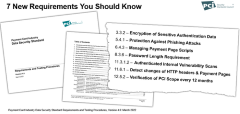

Payment Predictions: Preparing for 2024 Payment Trends
Chargebacks, compliance and contactless payments — oh, my! With so much change in technology and customer preferences regarding payments in recent years, 2024 is shaping up to be a time of evolution.
What do experts predict will be the defining payment trends of 2024? Here are several trends we believe will impact all businesses and how they interact with customers.
Growing Chargeback Challenges
So, what is a chargeback?
A chargeback — also called a payment dispute — is filed by a customer with their bank to address an actual or alleged fraud. During a chargeback, the bank withdraws the funds from the merchant’s account and returns them to the customer. On the other hand, a refund is a voluntary repayment from the merchant to the customer, usually when a product is returned or exchanged. When you compare chargeback vs. refund, the key difference is that a chargeback is initiated by the customer’s bank, whereas a refund is prompted by the merchant.
While refunds are simple and can be resolved directly between the merchant and the customer, chargebacks require bank intervention and pose a much greater reputational risk to merchants. These are increasingly expensive for businesses, especially online stores, as fraud increases and becomes more challenging to detect.
Chargebacks can pose a challenge for businesses that accept recurring payments. Even though automatic billing offers advantages for both customers and merchants, it increases the risk of chargebacks, even when customers can cancel their subscriptions easily.
Chargebacks have become a challenge for many businesses, and one reason for this is friendly fraud. Friendly fraud occurs when a customer disputes a legitimate charge. This can happen for various reasons, including forgetting they made a purchase or an unauthorized transaction. When combined with other fraudulent activities, This type of fraud can result in lost revenue, mounting chargeback fees, and a negative impact on the merchant’s reputation.
32.1% of customers say they’re often confused by billing descriptors.[1]
Clarify your transaction descriptions to reduce confusion and chargebacks.
So, how can you reduce friendly fraud to reduce chargebacks? It’s all about transparency and security. You can prevent disputes from the start with improved communication about policies and refunds. Authenticate customers with multi-factor authentication to confirm their identities and reduce unauthorized charges. Enhance security further with fraud detection and prevention tools, and ensure your billing descriptions are clear and concise to ensure customers recognize your business’ charges on their statements.
Continuing Rise of Contactless Payments
The prevalence and adoption of contactless payments is set to continue in 2024. Following the surge in adoption during the pandemic, contactless payments have become the preferred method for a growing number of merchants and customers alike, as they are considered a more hygienic and safer way to pay.
Adopting tap-to-pay technology allows faster transactions and less time spent managing card machines and cash, freeing up your resources for customer service and other tasks. Using tap to pay also increases transaction security through chip technology that encrypts data and protects customers from unauthorized or fraudulent charges, further expanding its value for customers.
As younger shoppers increasingly forego physical cards, businesses across industries can benefit from embracing contactless payments. But remember, contactless means more than just tap to pay. Digital wallets like Apple Pay, Google Pay, PayPal and more are increasing in popularity as they allow customers to keep all their cards and information in one easy-to-manage app for online and in-person transactions. Since digital wallets tokenize card numbers, they also provide an additional layer of security.
If you plan to implement contactless payments in 2024, ensure your solution offers seamless support for tap and digital wallet payments.
Contactless payments will account for over 50% of U.S. face-to-face card volume.[2]
The benefits of contactless payments are significant for all businesses — not just quick-service establishments. Even those who manage recurring payments can benefit from embracing this trend. Accepting digital wallet or tap payments can upgrade customer experiences with frictionless transactions and position your business as a modern operation willing to adapt to new technology. This may require upgrading your point-of-sale systems to allow contactless payments, but the benefits will be worth it.
Growing Adoption of Pay-by-Bank
In 2022, U.S. retailers paid $126.4 billion in credit card fees, a 20% increase from the previous year. Additionally, fees charged by banks to process card transactions increased by 16.7% in the same timeframe to reach $160.7 billion.[3] These mounting costs are driving many businesses — especially subscription-based businesses — to find ways new ways of reducing business costs.
The growing popularity of pay-by-bank options, also known as account-to-account (A2A) banking, is one of the most critical trends to help businesses save money. Pay-by-bank is a payment method that allows customers to make online purchases directly from their bank accounts without needing a credit or debit card.
In 2022, pay-by-bank transactions accounted for $525 billion in global e-commerce transactions.[4]
While the U.S. has lagged behind other countries in adopting pay-by-bank transactions, with ever-rising fees, many merchants are now seeking ways to limit transaction processing costs. Adding pay-by-bank transactions can dramatically reduce the overall cost of accepting payments (especially for subscription-based businesses with high monthly volumes) and increase cash flow with funds made available immediately.
Now that real-time, A2A payments are more prevalent, customers are more receptive to pay-by-bank payments, as transactions are reflected in their accounts faster. Pay-by-bank, or A2A transactions, are projected to grow through 2026.[5] With businesses’ increasing aversion to card fees, Forrester anticipates hundreds more banks and payment processors will offer pay-by-bank as an option.[6]
PCI Compliance Updates
Of course, we would be remiss in failing to address PCI DSS v4.0. The current guidelines, PCI DSS v3.2.1, will remain in effect through March 31, 2024, leading into a transitional period through March 2025, when the new 4.0 standards will become mandatory. While businesses have time to implement the new measures, experts recommend becoming compliant as soon as possible, as v4.0 contains some of the most significant changes to deter fraud and prevent security breaches in the last 20 years.
What can you expect from PCI DSS 4.0?
- Expanded authentication controls, including multi-factor authentication
- Updated password requirements, increasing required characters from 8 to 12
- Changing requirements around shared accounts
- New rules to prevent and detect fraud and cybersecurity threats
- Increased security for browser scripts
Ensuring PCI DSS compliance is a daunting process. Companies need to assess their current security to identify gaps before acting. After complying with the new standards, companies must test their systems and bring in a qualified auditor or assessor to review compliance and identify any remaining issues.
Nirmal Kumar, CTO and Head of Product at Aliaswire, says companies need to maintain constant vigilance to maintain systems, personnel and processes surrounding payment security and PCI compliance.
“A company might make large technology investments to become compliant, but because of the ever-changing security threats and upgrades to the standards, it’s hard to keep up,” said Kumar.
Download our white paper “The Impact of P2PE on PCI DSS Compliance” to learn more about payment security and PCI DSS requirements.
So, how can businesses manage increasing PCI standards while protecting their business and customers? “One of the things [businesses] can do is outsource… their billing and payment-related needs to fully integrated partners. And the reason I bring up fully integrated partners is because you do not want to compromise on your user experience,” said Kumar.[7]
Fully integrated partners are vital for reducing compliance burdens, and merchants should ensure they’re working with PCI-DSS-compliant payment gateways and service providers to maintain a secure environment and protect sensitive customer information. For example, Payway reduces the cost and resources required to achieve PCI-DSS compliance with point-to-point encryption (P2PE) as an add-on to our payment gateway. Our solution always meets regulations and will fully comply with PCI-DSS v4.0 standards by the end of 2024 — long before the March 2025 compliance deadline.
Conclusion
The modern payments landscape is evolving fast, and companies that can’t keep up with critical security and compliance regulations while offering the functionality and options customers expect, will fall behind quickly. Between fees, chargebacks, and rising fraud rates, many will shift their payment methods to reduce costs while also addressing the new PCI DSS v4.0 rules. Many changes are on the horizon, but we anticipate 2024 will be a complex and exciting year for payment trends worldwide.
If you’re looking to modernize your company’s payment processing, add new payment methods for your customers or reduce fees with Payway’s cost-plus pricing, don’t hesitate to reach out to our concierge sales support team. We’re here to help and answer any questions you may have!
[1] Chargebacks911. 2023 Chargeback Field Report. [Link]
[2] Forbes. Payments in 2024: 5 Predictions for the Year Ahead. [Link]
[3] Supermarket News. Retailers Paid $126.4B in credit card processing fees in 2022. [Link]
[4] Worldpay from FIS. The Global Payments Report 2023. [Link]
[5] Worldpay from FIS. The Global Payments Report 2023. [Link]
[6] Forrester. Predictions 2024. The Winners Will Be Those Who Weave Value Around Payments. [Link]
[7] Payments Journal. Navigating the Ever-Changing Landscape of PCI Compliance. [Link]


